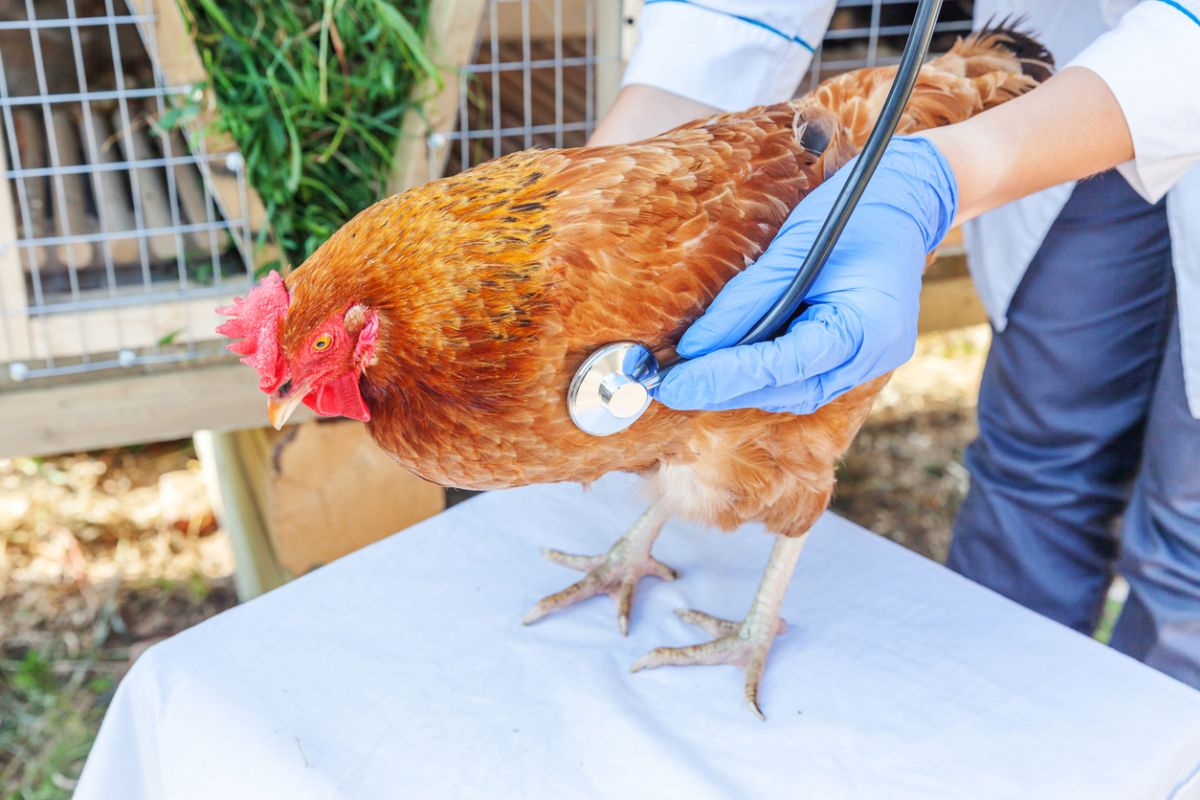Keeping birds healthy is a crucial part of being a chicken keeper. While most breeds aren’t prone to many chicken diseases, it’s always possible for issues to arise. So, what health concerns should you be aware of?
Most Common Chicken Diseases
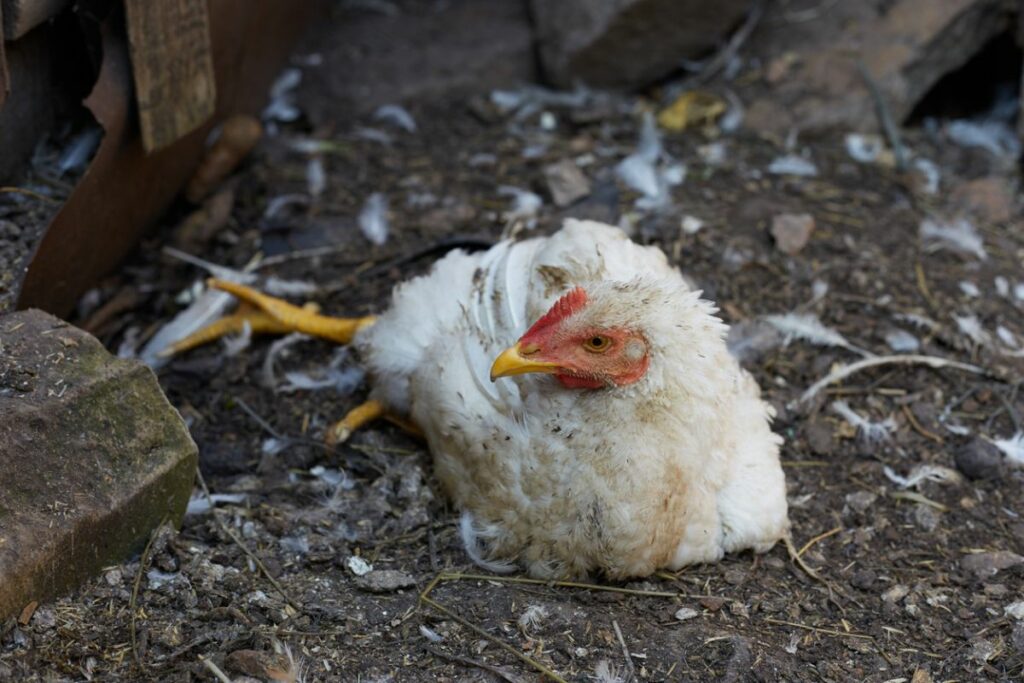
Here are 11 chicken diseases and treatment options to help you properly care for your flock in an emergency. Chicken disease prevention is crucial, so just being aware of these concerns could protect your birds.
#1 – Fowl Pox
Fowl pox is a disease like chicken pox, but for birds. It’s itchy, unpleasant-looking, and highly contagious. There are two main types of this chicken skin disease: dry pox and wet pox.
Symptoms
Chickens with dry pox will have wart-like bumps around the unfeathered areas of their body, such as their comb. If the bird has the wet form, the lesions will mostly appear around their mouth, caused by eye discharge. In young birds, this disease could stunt their growth.
Treatment
The only treatment for fowl pox is time. The bumps will go away on their own after a few weeks. If a chicken in your flock has it, separate them from the other birds and give them a comfortable space to heal.
Prevention
You may be able to get vaccines for your chickens to prevent this condition. It’s also a good idea to control mosquitos in your chicken enclosure because bugs could carry the virus from a bird to your flock. If you ever notice unusual warts on a chicken, separate them from the other birds and determine whether or not it’s fowl pox.
#2 – Coccidiosis
When it comes to chicken diseases coccidiosis is one of the most common. If your chicken has this parasitic infection, Coccidian protozoa will damage part of their gut.
Symptoms
Chickens suffering from coccidiosis will have digestive problems like loose stools or bloody diarrhea. Your chickens may also experience weight loss or ruffled feathers because their bodies will have a harder time absorbing nutrients.
Treatment
Antibiotics and other medications are the easiest way to get rid of this disease. You may need to visit a vet to get the proper treatment. There are six types of Eimeria, which is the coccidiosis parasite. So, even if your chicken becomes immune to one kind, they won’t be fully protected.
Prevention
You may be able to vaccinate chickens to prevent coccidiosis, so talk to your vet about that option. Either way, you should make sure your flock’s food bowls, coops, and brooders are clean and dry at all times. That lowers the risk of bacteria building up in their enclosure.
#3 – Fowl Cholera
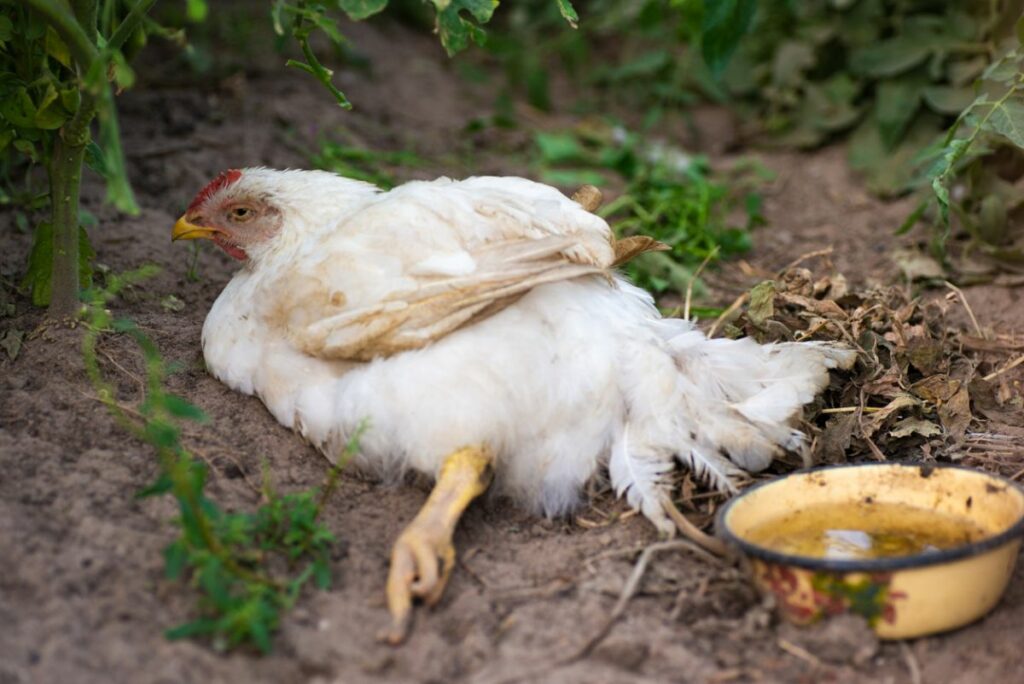
This is a chronic bird disease caused by bacteria called Pasteurella Multocida. It can affect several areas of a bird’s health, including their joints, sinuses, and tissues.
Symptoms
The most common symptom of fowl cholera is diarrhea that appears yellow or green. Some chickens will also face breathing problems, swollen joints, a discolored wattle or comb, or nasal discharge. In extreme cases, the bird could face sudden death.
Treatment
Unfortunately, there’s no official treatment method. Even if a chicken survives, they can still carry the disease, so many keepers put them down to end their suffering. However, you should always discuss options with your vet before taking extreme measures.
Prevention
There is a vaccine that can prevent fowl cholera. Cleaning and disinfecting surfaces of the coop regularly can also prevent bacteria, including those leading to this awful disease.
#4 – Avian Influenza
Avian influenza is also commonly known as the “bird flu.” It’s a disease caused by type A Orthomyxoviruses. It’s possible for this chicken disease in humans to occur, but it’s rare.
Symptoms
Common symptoms of avian influenza include diarrhea, nasal discharge, face swelling, or discoloration on the comb and wattle. You may also notice coughing and sneezing.
Treatment
Sadly, once a chicken has this flu, there’s no treatment. In most cases, the bird will have to be put down since it’s highly contagious. After removing the infected bird, disinfect the whole coop to keep other chickens safe. A bird who has avian influenza will always be a carrier of it.
Prevention
There isn’t a vaccine for this disease yet. The only way to prevent it is by consistently cleaning your coop to prevent bacteria from becoming exposed to your chickens.
#5 – Infectious Bronchitis
Infectious bronchitis is the equivalent of a human cold for chickens, so it’s contagious for other birds. If one chicken is showing symptoms, it’s likely that more will follow.
Symptoms
Chickens with this disease will commonly suffer from respiratory issues like coughing, sneezing, and snoring. Many chickens will have eye and nasal discharge too. They may also eat, drink, and produce eggs less.
Treatment
This is a disease that you’ll have to be patient with. You may be able to give them antibiotics to reduce symptoms, but for the most part, you’ll just have to wait for it to go away on its own. If a chicken is showing symptoms, put them in a comfortable space away from the other birds since the disease can spread quickly.
Prevention
There are a few chicken vaccines that can prevent this disease, so ask your vet about those. As usual, keeping the coop clean is a great way to reduce the risk. It’s especially important to keep rodents out of your chicken enclosure.
#6 – Infectious Coryza
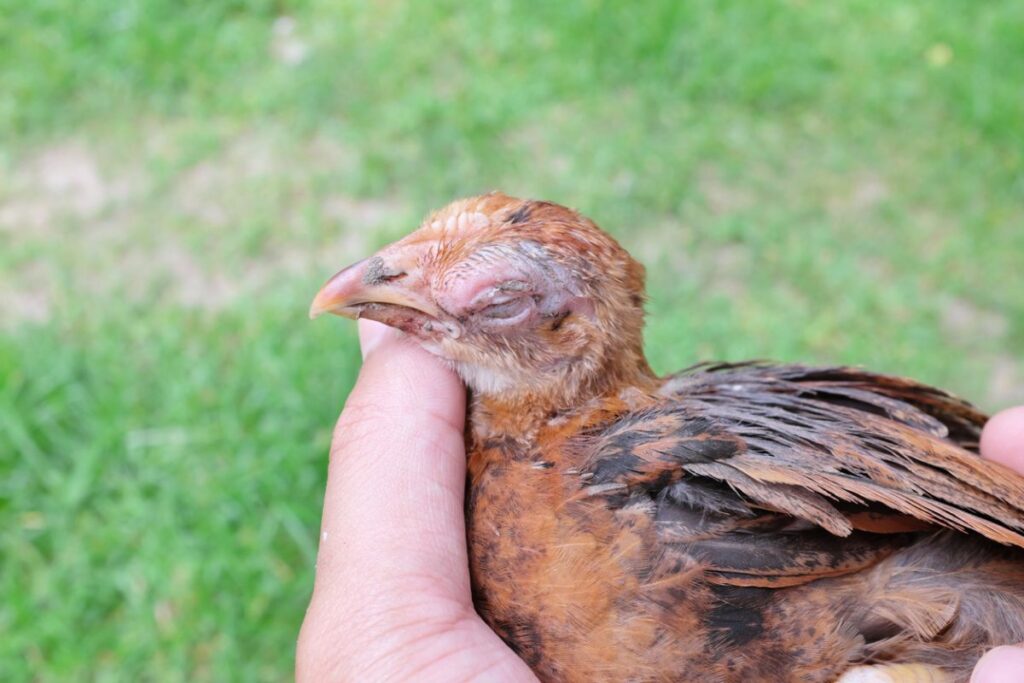
Infectious coryza is another chicken respiratory disease that’s highly contagious. Symptoms are obvious but not easily treated.
Symptoms
Birds infected with this chicken eye disease will have swollen heads, especially around their eyes and combs. You may notice eye and nasal discharge, along with moisture under their wings. Chickens with infectious coryza usually stop laying eggs.
Treatment
Once a chicken is infected, there’s not much you can do. Even if a chicken survives, they’ll still carry the bacteria. So, most keepers choose to put the bird down for the flock’s safety.
Prevention
There’s no vaccine, but with caution, you can prevent this disease. The bacteria is transmitted through contaminated water, birds, and surfaces. So, if you keep your chickens away from strange birds and keep their water clean, it’s unlikely they’ll get sick.
#7 – Marek’s Disease
Marek’s disease, also known as fowl paralysis, is common for young chickens. Most chickens that get it are between 12 and 25 weeks old. It’s considered a form of “avian cancer.”
Symptoms
Chicks infected with this disease will have tumors growing inside and/or outside of the body. Some other symptoms are irregularly-shaped pupils, vision loss, and partial paralysis. This dangerous disease can spread between birds quickly.
Treatment
There’s not much you can do if a young bird catches this disease. Even chicks that survive will continue to carry the disease. If one of your birds catches it, it’s safest to remove them from the flock and put them down.
Prevention
Luckily, vaccines are available to protect your chicks. Talk to your vet about vaccinating your newly hatched birds to reduce the risk as much as possible.
#8 – Newcastle Disease
This is another respiratory disease that can spread quickly. Both domesticated and wild birds can suffer from it, but birds in captivity are more likely to experience severe symptoms. If you touch an infected bird, you could accidentally pass the bacteria on to other chickens too.
Symptoms
Some symptoms include breathing problems, nasal discharge, murky eyes, and reduced egg production. Parts of their bodies, such as their legs and wings, could become paralyzed. Older birds are the most likely to survive.
Treatment
Chickens can safely recover without carrying the disease, but sadly, most birds don’t survive. You can talk to your vet about antibiotics to reduce your chicken’s symptoms, but other than that, there’s not much you can do.
Prevention
Vaccinating your flock is the best way to keep them safe from this deadly disease. Since it can spread so quickly, you should wash the chicken enclosure often and wash your hands after every time you touch a bird.
#9 – Botulism
Botulism is a rare condition, but it can be fatal for chickens. It’s a serious disease that can quickly progress if not handled early on.
Symptoms
This disease can cause tremors, breathing problems, and paralysis. The bird’s feathers may fall out or be easy to pull out. Sadly, most chickens die within hours of showing these symptoms.
Treatment
You may be able to purchase an antitoxin from your vet if you hurry. Giving them a mixture of Epsom salts and warm water may help too. However, you need to act fast to ensure that it doesn’t worsen.
Prevention
This disease is contracted if the chicken was exposed to an infected carcass. So, as long as you keep the enclosure clean and free of dead animals, your flock should be safe.
#10 – Bumblefoot
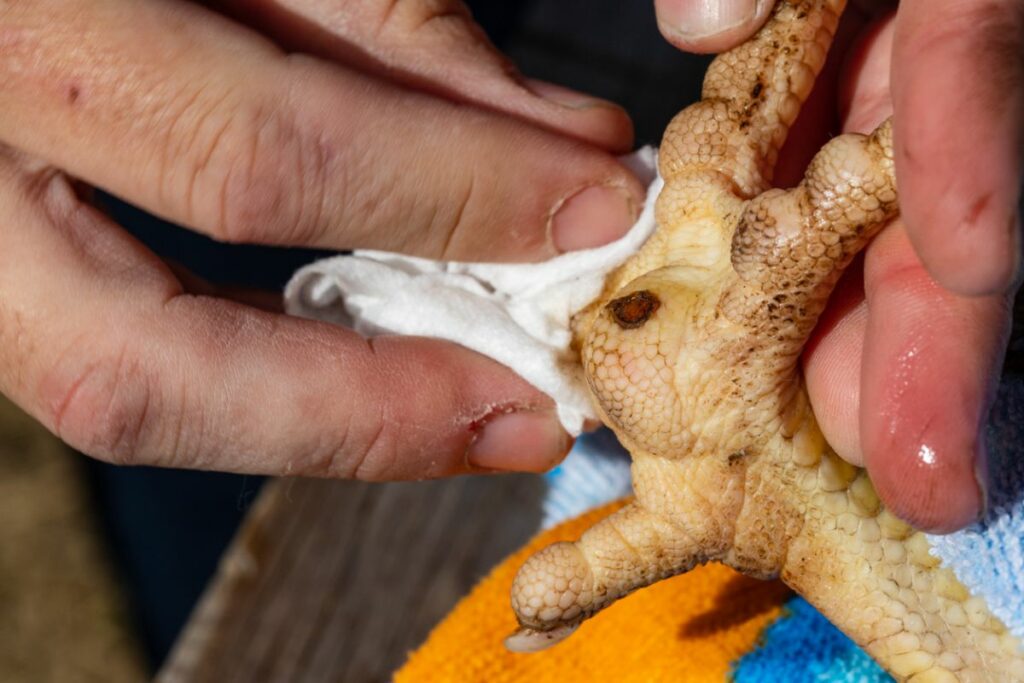
Chickens can get bumblefoot if they cut their foot and the cut gets infected. Luckily, it’s unlikely to cause severe complications or death.
Symptoms
Bumblefoot looks like a bump on your chicken’s foot with a dark spot in the middle. The longer it goes untreated, the larger the bump will appear.
Treatment
There are a few treatment methods, including antibiotics, soaking the foot, or using bandages. In extreme cases, surgery may be needed.
Prevention
To prevent bumblefoot, you should keep an eye out for sharp objects when cleaning the enclosure. Remove sharp rocks, thorns, or anything else that could cut your chicken’s foot. Regularly inspect your chickens’ feet for signs of bumblefoot and other chicken diseases.
#11 – Mushy Chick Disease
This unpleasant-sounding disease only infects chicks, but it’s severe. It can quickly spread from chick to chick, so it’s important to spot it early on.
Symptoms
Chicks that have mushy chick disease will have an enlarged and inflamed midsection of their body. They may have discoloration, weakness, and an unpleasant scent.
Treatment
Sadly, a chick that’s infected cannot be cured, and they will put the other chicks in danger. Yet, antibiotics may be able to cure some birds, so separate the infected chicks from the healthy ones to help them recover while keeping the other chicks safe.
Prevention
There’s no vaccine for this disease. The only way to protect chicks is to keep their space clean. Be careful when handling ill chicks because the bacteria they carry may harm humans.
Frequently Asked Questions
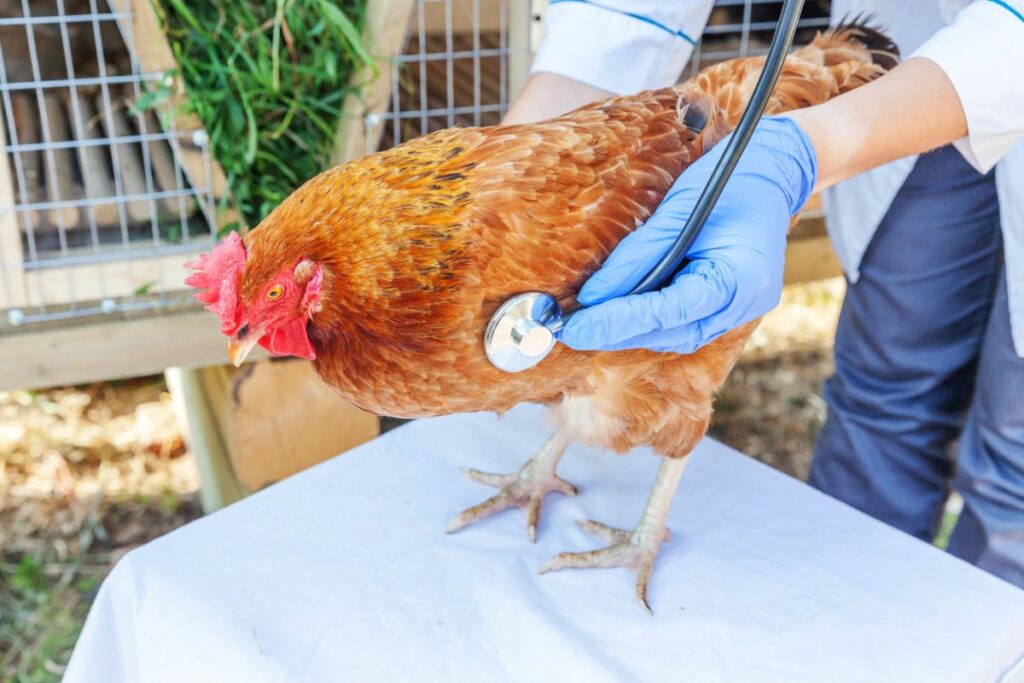
Now that you know all the common chicken diseases, you may have some lingering questions. Here are some topics chicken keepers might wonder about.
No, chickens cannot get the same chicken pox that humans get. However, fowl pox is a similar disease, but it affects birds instead of people. It’s unclear why the human disease is called chicken pox.
Consuming raw chicken could give you Salmonella and other dangerous bacteria. Salmonella can be passed between humans and animals, so it’s possible for your chickens to get infected with Salmonella too. Even if a chicken is healthy, they could still carry the virus and pass it to others.
Keeping Your Chicken Safe from Chicken Diseases
The best way to keep your chicken safe is to vaccinate them if possible and keep their space clean. Disinfect surfaces and replace their food and water regularly. Chickens with a healthy environment are much less likely to get sick.
These chicken diseases might sound intimidating, but it’s unlikely that your flock will get sick if you take good care of them. For the most part, chickens are easy to care for, but it’s always good to be aware of these diseases just in case. In addition to these concerns, don’t forget to prevent mites and worms too!
